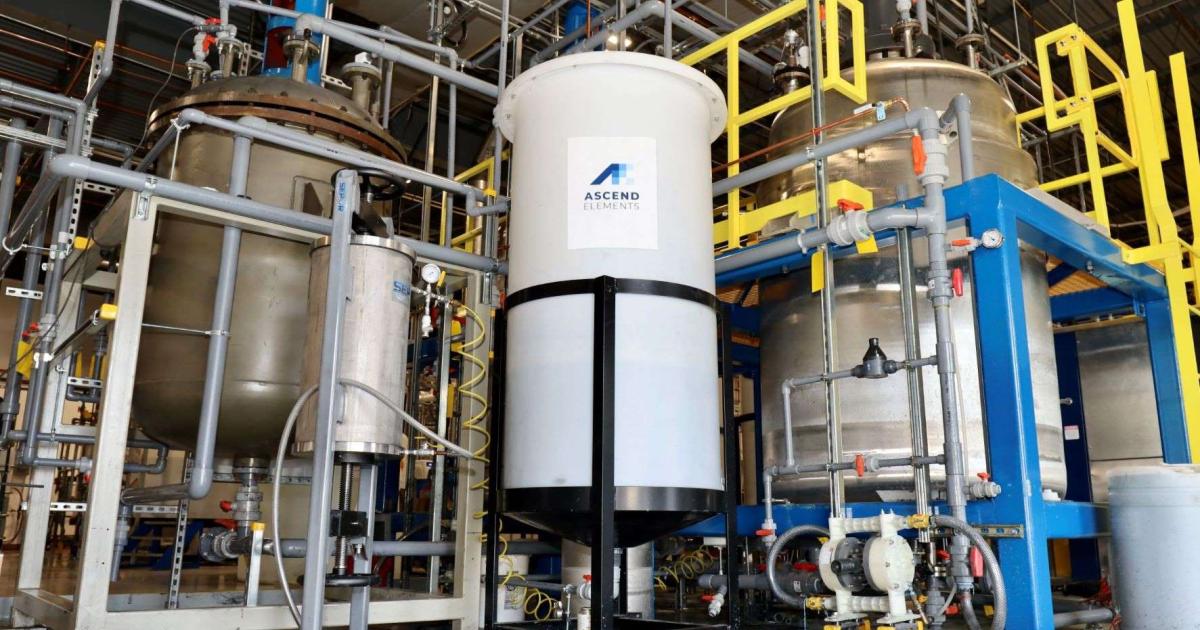
The lithium-ion batteries that power electric vehicles are well-known, at this point, as the main culprit for the environmental impact associated with manufacturing EVs.
There are obvious carbon emissions generated by the mining of metals for EV batteries, not to mention high water usage and potential human rights abuses.
But a new sector of tech companies are hoping to change that through “urban lithium mining,” or more simply put, battery recycling. The growing stream of retired lithium-ion batteries — in everything from old consumer electronics to electric cars — is being intercepted by recycling outfits that process the material and send it right back into the battery manufacturing pipeline.
Take, for example, Ascend Elements. The company collects those old batteries, and an even bigger portion of battery manufacturing scrap, and funnels it into a facility in Covington, Georgia — the largest of its kind in North America.
The materials are sorted, with any waste either recycled or sold off, but never sent to a landfill. From there, it puts the black mass available in the batteries through a shredding process, a standard first step in battery recycling. What happens next is what differentiates Ascend Elements from the rest: Using a process it calls “Hydro-to-Cathode,” the black mass is converted into cathode active materials that go directly back into new battery constructions.
“When you look at recycling companies, the one thing they all have in common is they all bring in battery material,” said Ascend Elements CEO Mike O’Kronley. But what they do with it, and what kind of materials come out the other end, is what matters for the circularity of the battery manufacturing system.
Because the cathode materials in EV batteries are often the most carbon-intensive piece, Ascend’s recycling process can render batteries a lot more sustainable. “We are able to reduce the carbon footprint of our cathode materials by over 90 percent,” O’Kronley said. “Just by swapping out that material alone … allows that EV to now have the same carbon footprint as an [internal combustion engine] vehicle from 0 miles.”
Shredding battery materials, however, is not the only path to a more sustainable battery. The American Battery Technology Company is pioneering a different method, one that de-manufactures batteries through a selective extraction process.
The tech was developed about three years ago, and is just becoming operational, according to ABTC chief executive Ryan Melsert. It works by targeting common “failure points” in the batteries that cause the materials to fall apart.
“We’re intentionally causing those failure modes to happen, to have those materials separate from each other in a much more strategic way,” Melsert said.
This avoids many of the chemically intensive processes used by other manufacturers. Plus, no furnaces or shredders are involved. “We don’t have any operation that is at high temperature. We have no combustion anywhere on site,” Melsert said.
It allows the company to recover not just the small quantities of high-value material, but also medium-value materials that most recyclers don’t go after. ABTC is able to recover 70 percent of the battery by mass and return it to the market. Much like Ascend’s method, all of the end products from ABTC can go back into EV batteries. “We intentionally designed the process not to downcycle the material,” Melsert said.
Both Melsert and O’Kronley, however, acknowledge that battery recycling still has a long way to go, as it provides a very small portion of EV battery materials. It’s mostly limited by the amount of old or scrap battery material that they can collect in the first place.
O’Kronley sees a clear path to a future, a couple of decades on, where recycled batteries account for most of the market, especially as more EVs are retired and consumers trade them in for newer models.
“Once we get to maturity, we will certainly be at these very high recycling rates. There’s no technical reason that we can’t get there,” O’Kronley said.
And Melsert’s company is playing a role in making that happen faster, with an entire arm of the company dedicated to developing more sustainable methods of primary lithium mining.
“Before you close the loop, the first thing you need to do is fill the loop the first time,” Melsert said.
The post "Battery recycling, two ways" appeared first on Green Biz








0 Comments